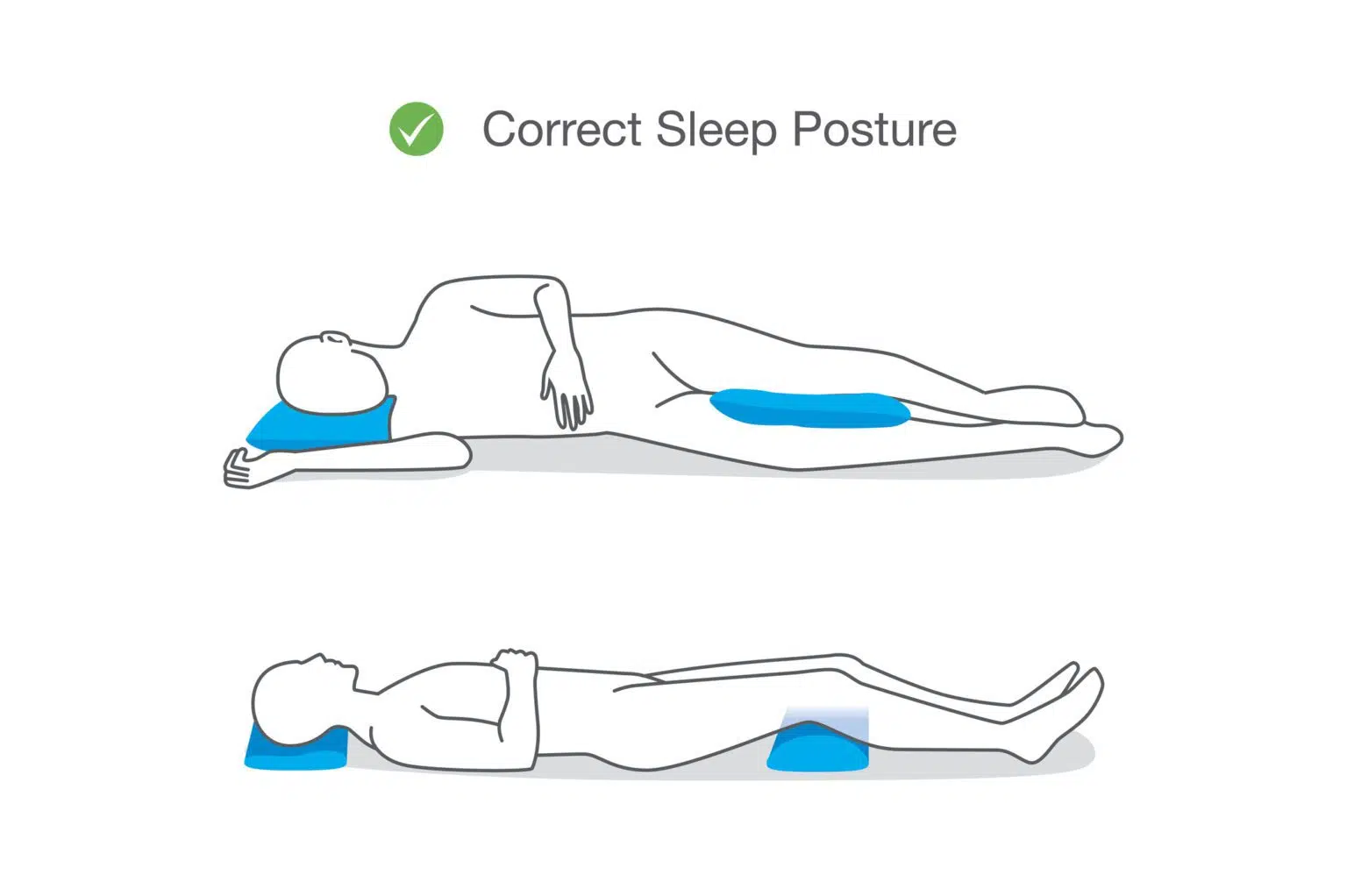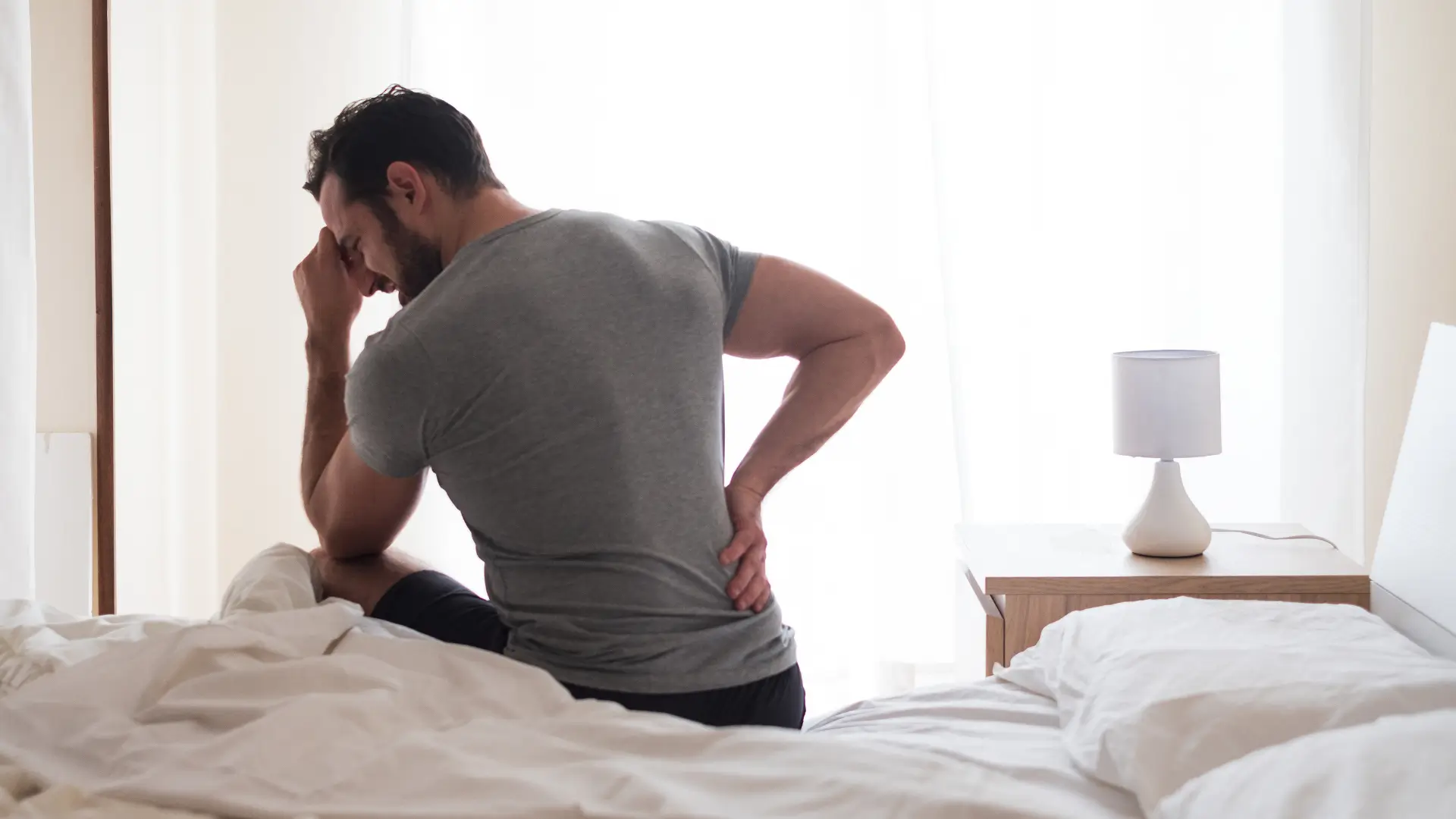Waking up with back pain is a widespread issue that affects the lives of many people, impacting the quality of rest more than you might realise.
Although it can be a disruptive and sometimes chronic concern, small changes in how you sleep can make a significant difference. In this article, we take a closer look at sleep positions and how to alleviate discomfort. We outline the different types of back pain and offer guidance to help you sleep more comfortably and wake up feeling restored.
Best sleeping positions for back pain

Most people tend to sleep on their side, back, or stomach. While personal preference plays a role, sleeping on your side or back is generally more supportive of spinal alignment than lying face down. No matter your preferred position, strategic use of pillows can help relieve pressure points and reduce discomfort during the night.
How to sleep on your side
Sleeping on your side, especially with knees slightly bent and a supportive pillow between them, is known to be the most effective posture for relieving lumbar stress. This alignment preserves the spine’s natural curve and reduces pressure, helping to ease discomfort and improve sleep quality.
It’s important to ensure your primary pillow is suited to side sleeping. A contour pillow helps to support the head, neck, and shoulders, reducing muscle tension and minimising strain. Your mattress also plays a key role – it should offer adequate cushioning around the hips and shoulders to prevent pressure build-up and restless movement during the night.
How to sleep on your back
Lying on your back provides even weight distribution and encourages proper spinal alignment, although pregnant women and sufferers of respiratory illnesses may not be suited to sleeping this way. To minimise discomfort and reduce tension, place a pillow beneath your knees. If your mattress is on the firmer side, a small lumbar cushion may offer added relief.
As with side sleepers, those who rest on their back should select a pillow designed to support proper alignment. Ideally, the pillow should maintain the natural line of the head, neck, and shoulders with the spine and hips. Avoid pillows that elevate the head too much or allow it to sink too low, as either can lead to strain and discomfort upon waking.
How to sleep on your stomach
Sleeping on your stomach can increase the risk of back pain, particularly if your mattress lacks proper support. In this position, the hips often sink into the mattress, disrupting spinal alignment and putting strain on surrounding muscles. Placing a slim pillow under the pelvis can reduce stress on your lower spine and neck.
A medium to firm mattress is typically recommended, ideally one that features responsive support technology to help maintain healthy posture throughout the night. Neck discomfort is also common in this posture, especially without the right pillow. Opt for a soft, low-profile pillow that keeps your head closer to the mattress surface. A pillow that is too firm or high may cause the neck to tilt upward, contributing to tension and pain in both the neck and back.
The two types of back pain
Broadly speaking, back pain typically falls into one of two categories: acute or chronic.
- Acute back pain is generally short-term, lasting anywhere from a few days to several weeks. It often arises suddenly and is commonly linked to physical strain or injury.
- In contrast, back pain is considered chronic when it persists for more than three months. It may not always have a clear cause and can vary in intensity, appearing intermittently or remaining constant. Chronic back pain affects general mobility, daily function and long-term wellbeing.
Back pain related to sleep can become chronic over time if not treated. It is often felt in the mid to lower back and may be present both during the night and throughout the following day. While adjusting your sleep position can offer meaningful relief, it’s important to consult a healthcare professional if your symptoms persist or worsen.

Can your mattress cause back pain?
A poor sleeping position or the wrong pillow is often blamed for back discomfort, but your mattress can be just as responsible. If your mattress is ageing, poorly constructed, or not designed with spinal support in mind, it may be contributing to your pain.
An unsupportive mattress can lead to misalignment of the spine for extended periods during the night, placing undue strain on surrounding muscles. Inadequate pressure relief may also cause frequent tossing and turning, further disrupting your sleep. Through our ongoing research with the Orthopaedic Advisory Board, we’ve found that a firm mattress isn’t always the answer when it comes to managing back pain.
Can a mattress be too firm?
Yes. A mattress that’s overly firm may not cushion you or contour to your body’s natural curves, leading to insufficient spinal support and resulting in tension or stiffness.
Can a mattress be too soft?
Absolutely. If your mattress is too soft, your body may sink excessively, particularly around the hips, forcing your muscles to overcompensate in an attempt to maintain alignment throughout the night.
Matching firmness to your sleep style
- Side sleepers often benefit from a mattress with added cushioning or plush comfort layers, allowing the shoulders and hips to gently sink while keeping the spine aligned.
- Back and stomach sleepers typically require a firmer feel, which helps prevent the hips and midsection from dipping too far and straining the lower back.
Your comfort preferences, body type, and sleeping posture all play a crucial role in determining the ideal mattress for you. The best way to find the right fit is to test the mattress in person, ensuring it supports both your comfort and spinal health.

Tips for improving sleep when managing back pain
While adjusting your sleep position is an important step, there are several other strategies that may help enhance the quality of your rest – particularly when dealing with persistent back discomfort.
- Incorporate gentle stretching: Light stretching before bed can help release muscle tension and prepare your body for rest. Avoid vigorous exercise too close to bedtime, as it may have the opposite effect. Always consult a healthcare provider before beginning any new stretching or mobility routine.
- Explore relaxation techniques: Establish a calming pre-sleep ritual. A warm bath, meditation, aromatherapy, or light reading can help signal to your body that it’s time to unwind. Limit screen time in the lead-up to sleep, as blue light may interfere with your natural sleep-wake cycle.
- Create a restful sleep environment: Aim for a bedroom that’s cool, quiet, and free from clutter. A peaceful, distraction-free space supports deeper, more consistent sleep and helps your brain associate the bedroom with relaxation and recovery.
- Limit stimulants and heavy foods: Avoid caffeine, alcohol, spicy dishes, or rich meals in the hours before bed. These can interfere with digestion and make it harder for your body to enter deep, restorative sleep.
Frequently asked questions
When sleeping on your side, place a pillow between your legs. If you lie on your back, try a pillow underneath your knees, and when lying on your stomach, place a pillow beneath your hips and pelvis.
The healthiest sleep position is one that maintains your spinal alignment. For many people, this is on the side or on the back. Ensure your pillow and mattress are suited to your sleeping position.
A mattress that is too soft can cause back pain especially if you sleep on your back or on your stomach. Without the right support, the hips and pelvis sink into the mattress, causing spinal misalignment and muscular strain.
A mattress that is too firm can cause back pain especially if you sleep on your side. Without the right conformance and cushioning, you may experience spinal misalignment and muscular strain.
A pillow can cause upper back pain if it does not suit your sleeping position. Back and side sleepers need adequate support to keep the head, neck and shoulders in alignment, while stomach sleepers often need soft, thin pillows. Ultimately, your head should not dip down or angle up too far.
The best mattress for back pain is one that maintains spinal alignment, offers sufficient cushioning and is made of high-quality, long-lasting materials. Every person’s needs are unique, so try our online Mattress Selector to find your perfect Sealy mattress.

Not sure what mattress is right for you?
Discover your perfect Sealy by using our mattress selector tool. Simply answer a few questions and we’ll recommend the right mattress based on your unique sleep profile.





